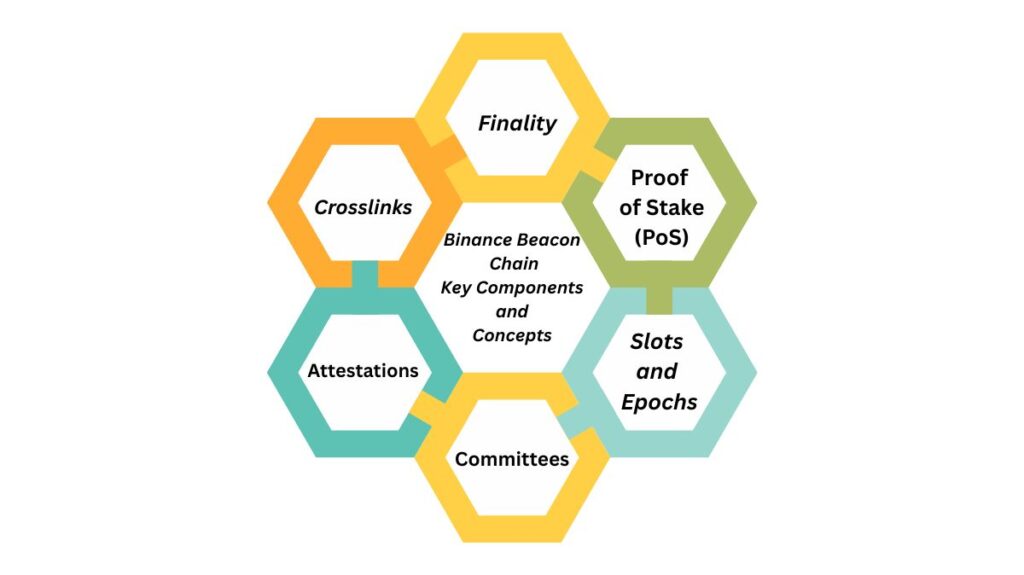What is Binance Beacon Chain

What is Binance Beacon Chain
As the Ethereum blockchain’s backbone and primary system chain, the Beacon Chain is an essential part of the network. It went live on December 1, 2020.
Core Purpose and Transition to Proof of Stake (PoS)
Ethereum’s Proof of Work (PoW) consensus method, which required validators to solve mathematical puzzles in order to add blocks, was in operation prior to the Beacon Chain. High energy usage, indirect centralisation vulnerability, and scalability challenges were among the major drawbacks this system encountered. Proof of Stake (PoS), which enables users to stake cryptocurrency to become validators, was chosen by the Ethereum Foundation as a solution to these issues.
The Beacon Chain introduced PoS to Ethereum. Ethereum switched from PoW to PoS at the Merge on September 15, 2022. Merge theoretically divided Ethereum into two interdependent layers: the Consensus Layer (Beacon Chain, or “Heart”) and the Execution Layer (Ethereum 1.0, or “Brain”).
What the Beacon Chain Does
For Ethereum blockchain maintenance and coordination, the Beacon Chain is required. It handles transaction validation, network validator coordination, block and consensus logic management, but not smart contract transactions.
Its key functions include:
- Validator and Stake Management: It stores and maintains a registry of validators and manages their statuses (e.g., deposited, pending, activated, slashed, exited, withdrawable). To become a validator, a user must deposit a minimum of 32 ETH as collateral.
- Consensus Enforcement: The PoS consensus process is enforced. In addition to providing validators with rewards and penalties, it enforces the consensus method. Slashing leads to a forced leave and additional sanctions for misconduct, while fines might lower a validator’s balance because of inactivity. Slashing can happen when a validator signs an attestation that encircles another, two blocks in the same epoch, or two attestations that contradict one another. They are reported by a “whistleblowing validator.”
- Randomness Generation: It produces good-quality randomness for selecting block proposers and attestation committees without bias, often using a RANDAO-based scheme. This random selection helps mitigate collusion by validators.
- Block Proposal and Attestation: It oversees the selection of attesters, who cast votes on the legality of proposed blocks, and block proposers, who construct new blocks.
- Keeping the Ethereum 2.0 network as a whole in sync is ensured by network synchronization. As principal connections, beacon nodes are in charge of keeping the clocks of all nodes synchronised and assisting other peers in synchronising the Beacon Chain in order to guarantee that penalty rules are applied correctly.
- Central System Chain for Shards: It serves as a central chain for shard chains to write their states, enabling future cross-shard transactions.
- Fork Choice Rule: In case of a fork, it uses the Latest Message Driven Greediest Heaviest Observed SubTree (LMD GHOST) rule to automatically select the correct chain based on the most attestations and stake.
- Finality: It applies the Casper the Friendly Finality Gadget (Casper FFG) method to guarantee that a block won’t revert after it has been finalised.
You can also read Sharding In Blockchain: How It Works And Types Of Sharding
Key Components and Concepts

Proof of Stake (PoS):
- Rather of mining with a lot of energy, PoS asks validators to stake a specific quantity of Ethereum as collateral.
- For the creation of new blocks, validators are chosen at random.
- Comparing this system to PoW, it uses less energy.
- Staking awards are used to reward validators, and they can also be penalised for misconduct.
Slots and Epochs:
- An allotted 12-second period for a validator to suggest a new block and certify its legitimacy is known as a slot. Should no block be offered, slots may be left unfilled.
- An epoch, which is a full round of the PoS protocol, is a bundle of 32 slots. A 6.4-minute epoch is complete.
Committees:
- A group of validators picked at random to agree on a time slot for adding a block is called a committee.
- There is usually a committee of at least 128 validators for each seat.
- The selection of committee members is pseudo-random in order to maintain decentralisation and avoid predictability.
- The committee is separated into two groups: Block Proposers, who suggest new blocks, and Attesters, who confirm that the blocks they have suggested are legitimate.
Attestations:
- Attestations vote on a block’s status depending on staked balance.
- Attestation is crucial to Ethereum blockchain consensus and integrity.
- Validators receive rewards for correct attestations but penalties for invalid blocks or failure to testify.
Crosslinks:
- In order to enable the beacon chain to follow the head of a shard chain, a crosslink is a reference in a beacon block to a shard block.
- Communication between shards, shard chain finality, and shard fork selection all depend on crosslinks.
Finality:
- Blocks in the first slot of an era are known as checkpoints.
- A checkpoint can be justified if it receives a ⅔ supermajority of votes from the sum of all validators who are currently active.
- The first justifiable checkpoint is considered finalised if it is followed by another in the next epoch. A typical checkpoint is completed in 12.8 minutes, or two epochs.
You can also read Fail Stop Fault: Benign Node Failures In Distributed Systems
Impact and Benefits
The Beacon Chain has impacted Ethereum by:
- Improving Energy Efficiency: Shifting from PoW to PoS significantly reduces the energy consumption of the network, making it more sustainable.
- Enhancing Scalability: While transaction processing and scalability were not immediately solved by The Merge, the Beacon Chain puts Ethereum on a path to higher scalability and reduced transaction costs (gas fees), particularly through its coordination of shard chains.
Boosting Security and Decentralization:
- PoS encourages ethical validator activity by financially discouraging unethical actors (such slashing).
- Because it is too expensive to obtain 51% of all staked Ethereum, it eliminates the centralisation problems associated with PoW mining pools.
- It is anticipated that the ease of becoming a validator (as opposed to mining) will promote increased decentralisation and participation.
Challenges and Future Developments
Notwithstanding its progress, there are still obstacles to overcome in the switch to Ethereum 2.0 (Serenity):
- Integration with Ethereum 1.0: The process involved complex coordination between the old and new systems.
- Sharding Implementation: Fully implementing shard chains is a complex process, ensuring they function correctly and integrate seamlessly with the Beacon Chain.
- Validator Incentives: Creating efficient systems for rewards and penalties is still essential to preventing underengagement or manipulative behaviour.
Proto-danksharding and full danksharding are two improvements that will further optimise the mainnet for other blockchains and focus on the complete integration of the Beacon Chain with the current Ethereum 1.0 chain.
Monitoring Beacon Chain Data
Beacon Chain data, such as proposer slashings, validator updates (balance changes, deposits), attestation information (epoch, slot number, committee index), and attester slashings, can be monitored through APIs offered by tools such as Bitquery. An Ethereum Beacon Chain API is also provided by Chainstack for querying setup, events, validator details, and state data.
You can also read Wasm Blockchain: The Next Generation of Smart Contracts
